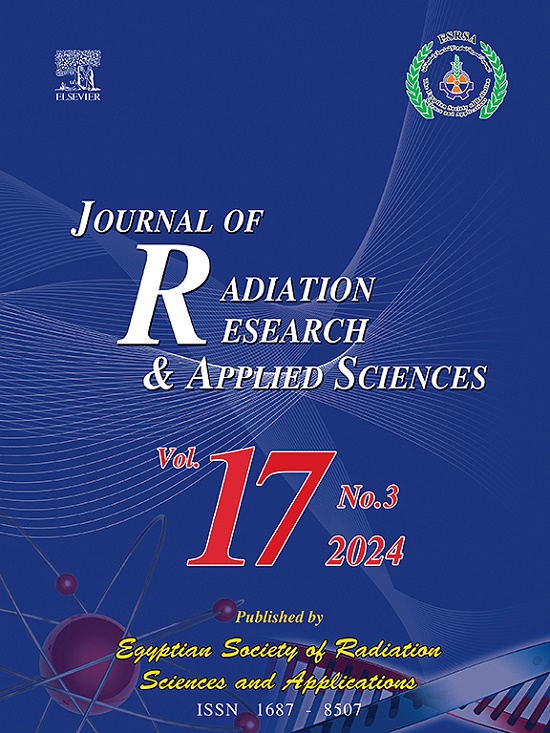Attention-enhanced deep learning and machine learning framework for knee osteoarthritis severity detection in football players using X-ray images
IF 1.7
4区 综合性期刊
Q2 MULTIDISCIPLINARY SCIENCES
Journal of Radiation Research and Applied Sciences
Pub Date : 2025-03-18
DOI:10.1016/j.jrras.2025.101428
引用次数: 0
Abstract
Objective
To develop a highly accurate, interpretable, and scalable framework for automated knee osteoarthritis (OA) classification, integrating attention-enhanced autoencoders for feature extraction and advanced machine learning techniques for robust and clinically reliable severity grading based on X-ray images.
Materials and methods
This study analyzed 5987 knee X-ray images from football athletes (18–45 years) using the Kellgren-Lawrence (KL) grading system. Preprocessing involved resizing, normalization, and quality checks, with data augmentation (rotations, flips, brightness adjustments) to enhance model robustness. A convolutional autoencoder (CAE) with attention mechanisms extracted key features, improving interpretability and accuracy. Machine learning classifiers (SVM, XGBoost, Stacking) processed features from the bottleneck layer, while dimensionality reduction (PCA, LDA, RFE) optimized feature selection, enhancing classification performance.
Results
The study assessed knee OA classification using autoencoders with and without attention mechanisms. Without attention, dimensionality reduction techniques like PCA and RFE performed well, particularly when combined with ensemble classifiers. RFE + Stacking achieved the highest F1-score (82.99 %), while PCA + SVM and PCA + XGBoost delivered high accuracy (86.57 % and 85.52 %, respectively). Incorporating attention mechanisms significantly boosted performance, with RFE + Stacking attaining the best overall results (AUC: 96.5 %, F1-score: 93.5 %). Additionally, PCA + Stacking and PCA + XGBoost demonstrated strong accuracy (92.99 % and 92.12 %, respectively). End-to-end autoencoders with attention outperformed their non-attentive counterparts, reaching an accuracy of 0.94 and an AUC of 0.95. These findings underscore the critical role of attention mechanisms in enhancing model robustness, accuracy, and interpretability, making them highly applicable for clinical decision-making.
Conclusion
This study introduces a highly interpretable AI framework for knee OA classification, integrating attention-enhanced autoencoders to highlight key diagnostic regions in X-ray images. By incorporating attention mechanisms, our model improves transparency and clinical relevance, ensuring that classification decisions are guided by meaningful radiological features rather than arbitrary patterns.
使用x射线图像检测足球运动员膝关节骨关节炎严重程度的注意力增强深度学习和机器学习框架
目的开发一个高度准确、可解释和可扩展的膝关节骨关节炎(OA)自动分类框架,集成用于特征提取的注意力增强自动编码器和先进的机器学习技术,以实现基于x射线图像的鲁棒性和临床可靠的严重程度分级。材料和方法本研究使用Kellgren-Lawrence (KL)分级系统分析了5987张18-45岁足球运动员的膝关节x射线图像。预处理包括调整大小、归一化和质量检查,以及数据增强(旋转、翻转、亮度调整),以增强模型的鲁棒性。卷积自编码器(CAE)的注意机制提取关键特征,提高可解释性和准确性。机器学习分类器(SVM、XGBoost、Stacking)处理瓶颈层特征,降维器(PCA、LDA、RFE)优化特征选择,提高分类性能。结果本研究使用带有和不带有注意机制的自动编码器评估膝关节OA分类。在没有注意的情况下,像PCA和RFE这样的降维技术表现很好,特别是当与集成分类器结合使用时。RFE + Stacking的f1得分最高(82.99%),PCA + SVM和PCA + XGBoost准确率较高(分别为86.57%和85.52%)。结合注意力机制显著提高了表现,RFE + Stacking获得了最好的总体结果(AUC: 96.5%, F1-score: 93.5%)。此外,PCA + Stacking和PCA + XGBoost具有较强的准确率(分别为92.99%和92.12%)。具有注意力的端到端自动编码器的表现优于非注意力编码器,达到了0.94的准确率和0.95的AUC。这些发现强调了注意机制在增强模型稳健性、准确性和可解释性方面的关键作用,使其高度适用于临床决策。本研究引入了一个高度可解释的膝关节OA分类AI框架,集成了注意力增强的自编码器,以突出x线图像中的关键诊断区域。通过结合注意机制,我们的模型提高了透明度和临床相关性,确保分类决策是由有意义的放射特征而不是任意模式指导的。
本文章由计算机程序翻译,如有差异,请以英文原文为准。
求助全文
约1分钟内获得全文
求助全文
来源期刊

Journal of Radiation Research and Applied Sciences
MULTIDISCIPLINARY SCIENCES-
自引率
5.90%
发文量
130
审稿时长
16 weeks
期刊介绍:
Journal of Radiation Research and Applied Sciences provides a high quality medium for the publication of substantial, original and scientific and technological papers on the development and applications of nuclear, radiation and isotopes in biology, medicine, drugs, biochemistry, microbiology, agriculture, entomology, food technology, chemistry, physics, solid states, engineering, environmental and applied sciences.
 求助内容:
求助内容: 应助结果提醒方式:
应助结果提醒方式:


